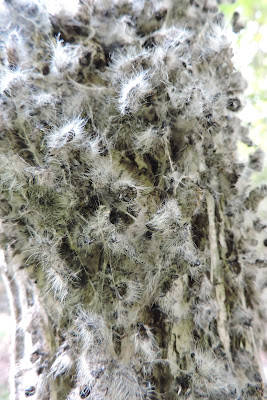 |
| A Walnut Caterpillar. You may be able to notice where it spit up on my hand. |
The Walnut Caterpillar (Datana integerimma) is a neat caterpillar with a mixed reputation. One of 13 species of what are sometimes called the Handmaid Moths, the Genus Datana, they can be difficult to tell apart. They all are very social, at least while young caterpillars, forming large groups. When disturbed they also all have an interesting defensive posture. They all in unison lift both ends of their bodies and arch themselves upwards. They may also regurgitate onto anything that attempts to grab them. Older caterpillars sometimes just let go and fall to the ground.
 |
| A Walnut Caterpillar starting to give the typical defensive posture of the Datana moths. |
The Walnut Caterpillar is much easier to tell apart than the others, lacking much of the markings the other members of the family have that make them all look so similar. They do indeed feed on walnuts, hickories, and pecans (some claim they feed on a few other species, but that's debatable). This can lead to their being considered agricultural pests, though that's more of an issue in the South where they can have multiple broods and defoliate production trees. In our area and further North, they only have one brood and so usually are not as much of a problem and the trees recover well. They are also a favorite food of many animals, so their numbers are usually kept in check.
These caterpillars have what maybe a unique behavior as well, that even other members of their Genus lack. They all molt, shed their skins each time they grow, in unison. Even caterpillars born at different times and of different sizes, all somehow synchronize it so they all shed their skins at the same time and in the same place. This usually results in a huge pile of caterpillars and then left over skins, in what may resemble a big hair ball, in the crotch of the tree.
 |
| The remains of the synchronized molt of the Walnut Caterpillars in a black walnut tree. |
As quickly as they seem to have appeared, they all seem to disappear. The last instar (molt) crawls to the ground and pupates underground, starting the process again the next summer.
Remarkable! Thanks for the post!
ReplyDeleteRemarkable! Thanks for the post!
ReplyDeletevery hairy looking!
ReplyDelete